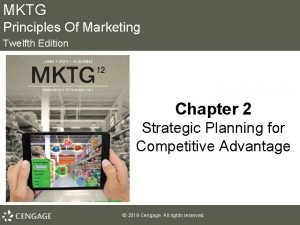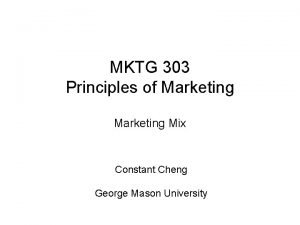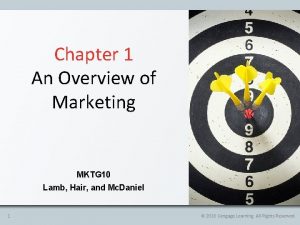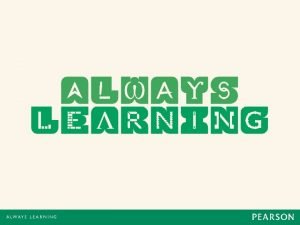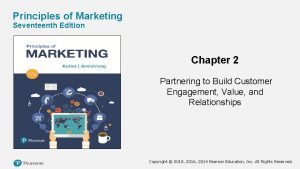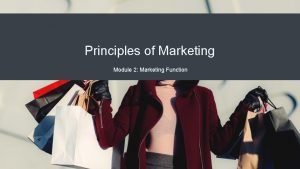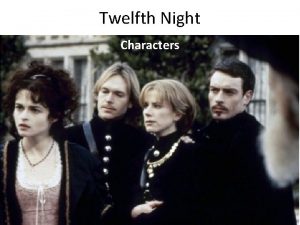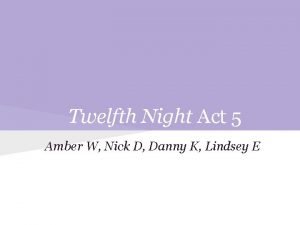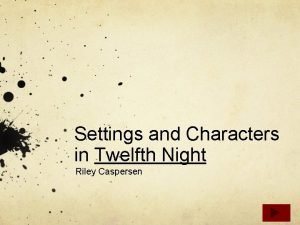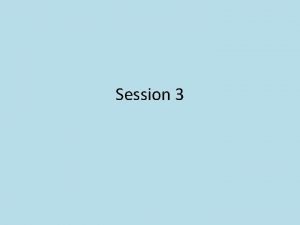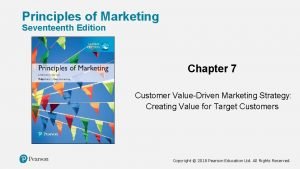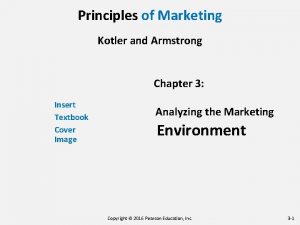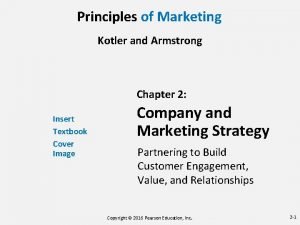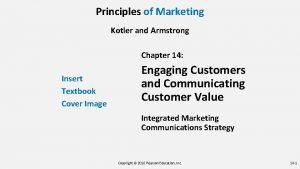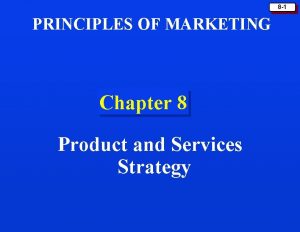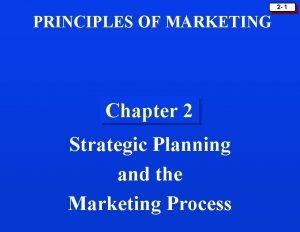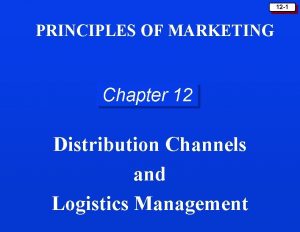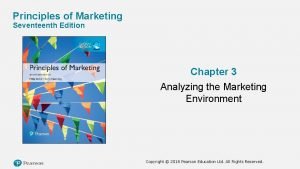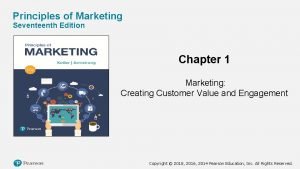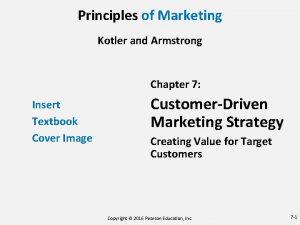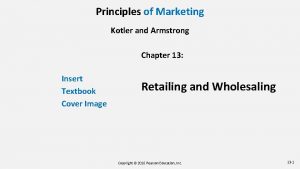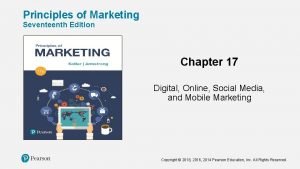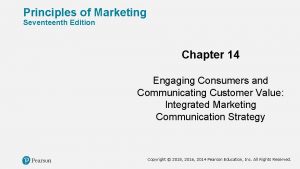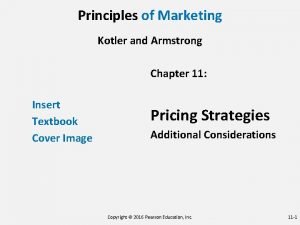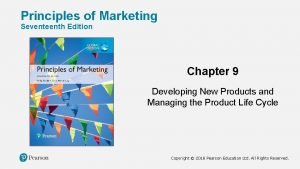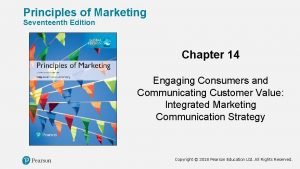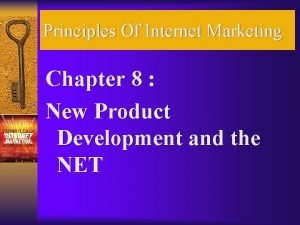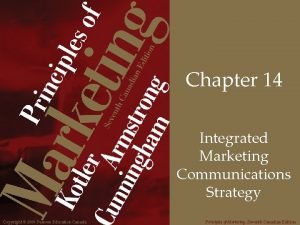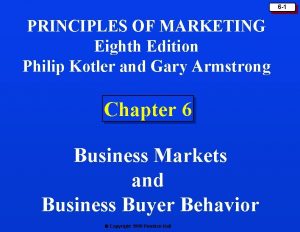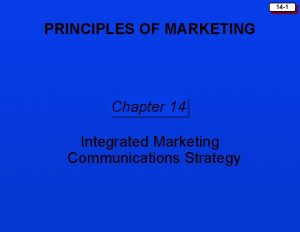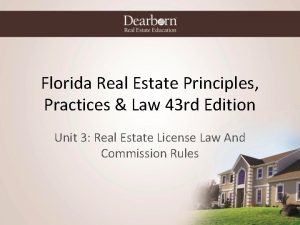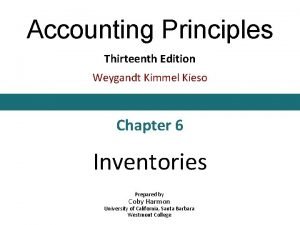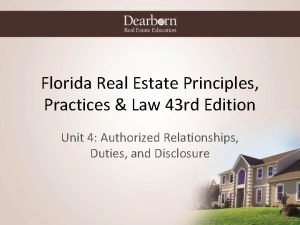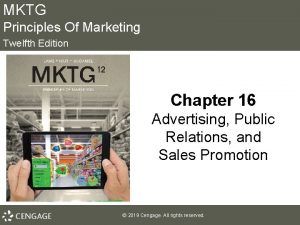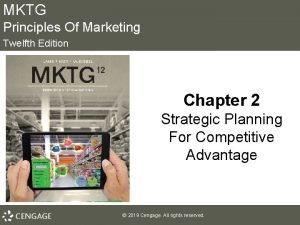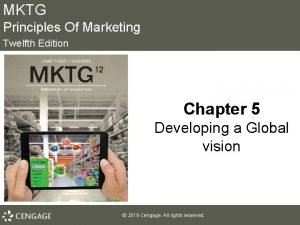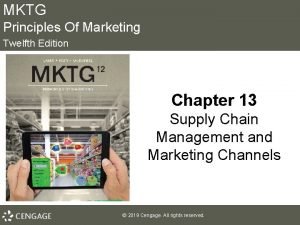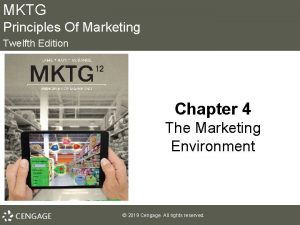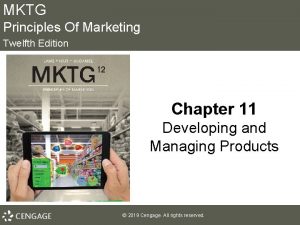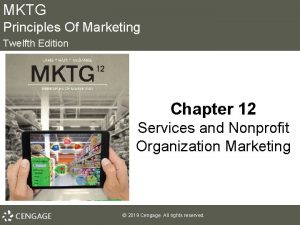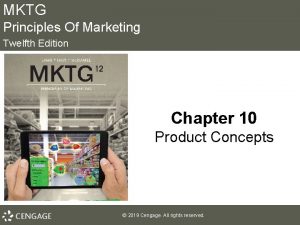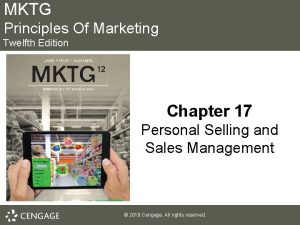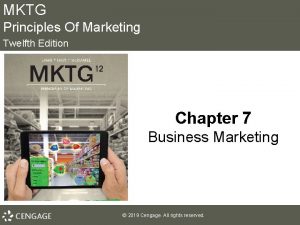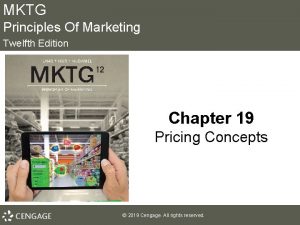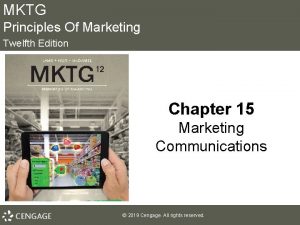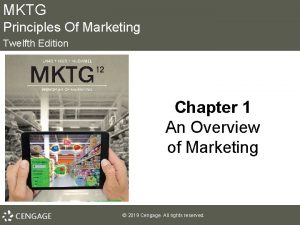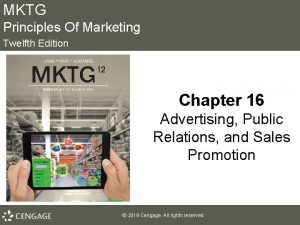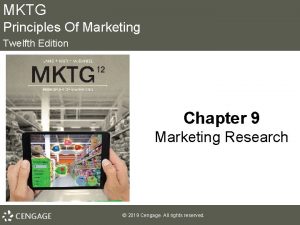MKTG Principles Of Marketing Twelfth Edition Chapter 6






































































- Slides: 70

MKTG Principles Of Marketing Twelfth Edition Chapter 6 Consumer Decision Making © 2019 Cengage. All rights reserved.

Learning Outcomes (1 of 2) 6 -1 Explain why marketing managers should understand consumer behavior 6 -2 Analyze the components of the consumer decisionmaking process 6 -3 Explain the consumer’s postpurchase evaluation process 6 -4 Identify the types of consumer buying decisions and discuss the significance of consumer involvement 6 -5 Describe how some marketers are reconceptualizing the consumer decision-making process © 2019 Cengage. All rights reserved.

Learning Outcomes (2 of 2) 6 -6 Identify and understand the cultural factors that affect consumer buying decisions 6 -7 Identify and understand the social factors that affect consumer buying decisions 6 -8 Identify and understand the individual factors that affect consumer buying decisions 6 -9 Identify and understand the psychological factors that affect consumer buying decisions © 2019 Cengage. All rights reserved.

Learning Objective 1: The Importance of Understanding Consumer Behavior © 2019 Cengage. All rights reserved.

Consumer’s behavior • Consumers’ product and service preferences are constantly changing. • Marketing managers must understand these desires in order to create a proper marketing mix for a welldefined market. • Understanding how consumers make purchase decisions can help marketing managers in several ways. © 2019 Cengage. All rights reserved.

Value • • Personal assessment of the net worth one obtains from making a purchase Perceived value: Value a consumer expects to obtain from a purchase Utilitarian value: Value derived from a product or service that helps the consumer solve problems and accomplish tasks Hedonic value: Value that acts as an end in itself rather than as a means to an end © 2019 Cengage. All rights reserved.

Learning Objective 2: The Traditional Consumer Decision-Making Process © 2019 Cengage. All rights reserved.

The Traditional Consumer Decisionmaking Process (1 of 2) • When buying products, particularly new or expensive items, consumers generally follow the consumer decision-making process: (1) need recognition, (2) information search, (3) evaluation of alternatives, (4) purchase, and (5) postpurchase behavior. • These five steps represent the traditional buying process, which can be used as a guide for studying how consumers make decisions. © 2019 Cengage. All rights reserved.

Exhibit 6. 1 : The Consumer Decision. Making Process (2 of 2) © 2019 Cengage. All rights reserved.

Need Recognition (1 of 2) • Result of an imbalance between actual and desired states • First stage in the decision-making process • Want: Recognition of an unfulfilled need and a product that will satisfy it © 2019 Cengage. All rights reserved.

Need Recognition (2 of 2) • Stimulus: Any unit of input affecting one or more of the five senses – Sight, smell, taste, touch, and hearing • Want-got gap: Imbalance between actual and desired states – Does not always trigger consumer action § Gap must be large enough to drive the consumer to take some action § Marketing manager’s objective: Get consumers to recognize the want-got gap © 2019 Cengage. All rights reserved.

Information Search • Internal information search: Recalling past information stored in the memory • External information search: Seeking information in the outside environment – Nonmarketing-controlled information source § Product information source that is not associated with promotion – Marketing-controlled information source § Product information source that originates with marketers promoting a product © 2019 Cengage. All rights reserved.

External Information Searches (1 of 2) • Customers seek less information about a product when there is: – – Less risk involved More knowledge and more product experience Low level of interest Confidence in the decision taken © 2019 Cengage. All rights reserved.

External Information Searches (2 of 2) • Customers seek more information about a product when there is: – – More risk involved Less knowledge and less product experience High level of interest Lack of confidence in the decision taken © 2019 Cengage. All rights reserved.

Evaluation of Alternatives and Purchase (1 of 3) • Consumer is ready to make a decision after creating an evoked set – Evoked set: Group of brands resulting from an information search from which a buyer can choose • Consumers evaluate and compare alternatives with the help of: – Environment – Internal information – External information © 2019 Cengage. All rights reserved.

Evaluation of Alternatives and Purchase (2 of 3) • Consumer has to make the following decisions: – – Whether to buy When to buy What to buy (product type and brand) Where to buy (type of retailer, specific retailer, online or in store) – How to pay © 2019 Cengage. All rights reserved.

Evaluation of Alternatives and Purchase (3 of 3) • Planned versus impulse purchase – Partially planned purchase: Made by consumers when they know the product category they want to buy but wait until they get to the store or go online – Unplanned purchase: Made by consumers on an impulse • Psychological ownership – Consumers sometimes develop feelings of ownership without even owning the good, service, or brand © 2019 Cengage. All rights reserved.

Learning Objective 3: Post purchase Behavior © 2019 Cengage. All rights reserved.

Cognitive Dissonance • Inner tension that a consumer experiences after recognizing an inconsistency between behavior and values or opinions • Consumers reduce dissonance by: – Seeking information that reinforces the purchase decision – Avoiding information that contradicts the purchase decision – Revoking the original decision by returning the product © 2019 Cengage. All rights reserved.

Learning Objective 4: Types of Consumer Buying Decisions and Consumer Involvement © 2019 Cengage. All rights reserved.

Cognitive Buying Decisions • All consumer buying decisions generally fall along a continuum of three broad categories: routine response behavior, limited decision making, and extensive decision making. • Goods and services in these three categories can best be described in terms of five factors: – – – Level of consumer involvement Length of time to make a decision Cost of the good or service Degree of information search Number of alternatives considered © 2019 Cengage. All rights reserved.

Consumer Involvement (1 of 2) • The level of consumer involvement is perhaps the most significant determinant in classifying buying decisions. Involvement is the amount of time and effort a buyer invests in the search, evaluation, and decision processes of consumer behavior. • Frequently purchased, low-cost goods and services are generally associated with routine response behavior. © 2019 Cengage. All rights reserved.

Consumer Involvement (2 of 2) • Limited decision making typically occurs when a consumer has previous product experience but is unfamiliar with the current brands available. • Consumers practice extensive decision making when buying an unfamiliar, expensive product or an infrequently bought item. © 2019 Cengage. All rights reserved.

Exhibit 6. 2: Continuum of Consumer Buying Decisions © 2019 Cengage. All rights reserved.

Factors Determining the Level of Consumer Involvement (1 of 2) The level of involvement in the purchase depends on the following factors: • Previous experience: When consumers have had previous experience with a product or repeated product trials, the level of involvement typically decreases and quick choices are made. • Interest: Involvement is directly related to consumer interests, such as cars, motorcycles, or electronics. © 2019 Cengage. All rights reserved.

Factors Determining the Level of Consumer Involvement (2 of 2) • Perceived risk of negative consequences: As the risk increases, so does the consumer's level of involvement. Risks include financial risks, social risks, and psychological risks. • Social visibility: Involvement increases as the social visibility of a product increases. The products that make a statement about the user may include cars, jewelry, furniture, and clothing. • High involvement can take a number of different forms. It can be product involvement, situational involvement, shopping involvement, enduring involvement, and emotional involvement. © 2019 Cengage. All rights reserved.

Factors Determining the Level of Consumer Involvement • • Previous experience Interest Perceived risk of negative consequences Social visibility © 2019 Cengage. All rights reserved.

Social Visibility (1 of 2) • Product involvement means that a product category has high personal relevance. • Situational involvement means that the circumstances of a purchase may temporarily transform a lowinvolvement decision into a high-involvement one. • Shopping involvement represents the personal relevance of the process of shopping. Many consumers also engage in showrooming— examining merchandise in a physical retail location without purchasing it and then shopping online for a better deal on the same item. © 2019 Cengage. All rights reserved.

Social Visibility (2 of 2) • Enduring involvement represents an ongoing interest in some product, such as kitchen gadgets, or activity, such as fishing. • Emotional involvement represents how emotional a consumer gets during some specific consumption activity. © 2019 Cengage. All rights reserved.

Marketing Implications of Involvement • High-involvement purchases: – Require extensive and informative promotion to the target market • Low-involvement purchases: – Require in-store promotion, eye-catching package design, and good displays – Coupons and two-for-one offers promote lowinvolvement items © 2019 Cengage. All rights reserved.

Learning Objective 5: Reconceptualizing the Consumer Decision Making Process © 2019 Cengage. All rights reserved.

Eliminating the Consider and Evaluate Phase • Automation – Streamlines journey steps • Proactive personalization – Uses information to customize the customer experience • Contextual interaction – Uses knowledge about where a customer is in the journey to deliver them to the next set of interactions • Journey innovation – Extends customer interactions to new sources of value © 2019 Cengage. All rights reserved.

Exhibit 6. 3 : The Consumer Decision Journey © 2019 Cengage. All rights reserved.

Factors Affecting Consumer Decision Making (1 of 2) • On the contrary, underlying cultural, social, individual, and psychological factors strongly influence the decision process. • These factors have an effect from the time a consumer perceives a stimulus and considers the product or service through postpurchase evaluation. • Cultural factors, which include culture and values, subculture, and social class, exert a broad influence over consumer decision making. © 2019 Cengage. All rights reserved.

Factors Affecting Consumer Decision Making (2 of 2) • Social factors sum up the social interactions between a consumer and influential groups of people, such as reference groups, opinion leaders, and family members. • Individual factors, which include gender, age, family life cycle stage, personality, self-concept, and lifestyle, are unique to each individual and play a major role in the type of products and services consumers want. © 2019 Cengage. All rights reserved.

Exhibit 6. 4: Factors That Affect the Consumer Decision Journey © 2019 Cengage. All rights reserved.

Learning Objective 6: Cultural Influences on Consumer Buying Decisions © 2019 Cengage. All rights reserved.

Culture and Values • Set of values, norms, attitudes, and other meaningful symbols that shape human behavior and the products of that behavior as they are transmitted from one generation to the next • Characteristics: – – Pervasive Functional Learned Dynamic © 2019 Cengage. All rights reserved.

Subculture and Social Class • Subculture: Homogeneous group of people who share elements of the overall culture as well as cultural elements unique to their own group • Social class: Group of people in a society – Considered nearly equal in status or community esteem – Regularly socialize among themselves both formally and informally – Share behavioral norms © 2019 Cengage. All rights reserved.

Exhibit 6. 5: U. S. Social Classes © 2019 Cengage. All rights reserved.

Impact of Social Class on Marketers • Social class indicates which medium to use for advertising. • Knowing what products appeal to which social classes help marketers determine where to best distribute their products. © 2019 Cengage. All rights reserved.

Learning Objective 7: Social Influences on Consumer Buying Decisions © 2019 Cengage. All rights reserved.

Social Influences • Many consumers seek out the opinions of others to reduce their search and evaluation effort or uncertainty, especially as the perceived risk of the decision increases. • Consumers may also seek out others’ opinions for guidance on new products or services, products with image-related attributes, or products for which attribute information is lacking or uninformative. – Reference Group – Optional Leaders – Family © 2019 Cengage. All rights reserved.

Reference Group (1 of 2) • A reference group consists of all the formal and informal groups that influence the buying behavior of an individual. • A primary membership group includes all groups with which people interact regularly in an informal manner, such as family, friends, members of social media, such as Facebook and coworkers. • In contrast, people associate with a secondary membership group less consistently and more formally. © 2019 Cengage. All rights reserved.

Reference Group (2 of 2) • An aspirational reference group is a group a person would like to join. • Nonaspirational reference groups, or dissociative groups, influence our behavior when we try to maintain distance from them. • For marketers, reference groups have three important implications: – They serve as information sources and influence perceptions; – They affect an individual’s aspiration levels; and – Their norms either constrain or stimulate consumer behavior. © 2019 Cengage. All rights reserved.

Exhibit 6. 6: Types of Reference Groups © 2019 Cengage. All rights reserved.

Optional Leaders • Reference groups and social media groups frequently include individuals known as group leaders, or opinion leaders—persons who influence others. • Individuals who influence the opinions of others • Influential, informed, plugged-in, and vocal members of society • Marketers are looking to social media to find opinion leaders, but the sheer volume of posts and platforms makes determining true opinion leaders challenging. • May be challenging to locate due to the volume of social media platforms © 2019 Cengage. All rights reserved.

Family (1 of 2) • The family is the most important social institution for many consumers, strongly influencing values, attitudes, self-concept, and buying behavior. • Moreover, the family is responsible for the socialization process, the passing down of cultural values and norms to children. • Family members assume a variety of roles in the purchase process. © 2019 Cengage. All rights reserved.

Family (2 of 2) – Initiators suggest, initiate, or plant the seed for the purchase process. – Influencers are members of the family whose opinions are valued. – The purchaser (probably Dad or Mom) is the one who actually exchanges money for the product. – Finally, the consumer is the actual user—in this case, Sister. • Marketers should consider family purchase situations along with the distribution of consumer and decisionmaker roles among family members. © 2019 Cengage. All rights reserved.

Individual Differences in Susceptibility to Social Influences • Not all persons are equally influenced in their purchase decisions. • Consumers differ in their feelings of connectedness to other consumers. – Separated self-schema: A consumer perceives himself as distinct and separate from others. – Connected self-schema : A person sees himself as an integral part of a group. © 2019 Cengage. All rights reserved.

Learning Objective 8: Individual Influences on Consumer Buying Decisions © 2019 Cengage. All rights reserved.

Individual Influences (1 of 2) • While individuality impacts a person’s susceptibility to social influences, factors such as gender, age, life cycle stage, personality, self-concept, and lifestyle also play important roles in consumer decision making. . © 2019 Cengage. All rights reserved.

Individual Influences (2 of 2) • Most people do not change their gender, and the act of changing personality or lifestyle requires a complete reorientation of one’s life. © 2019 Cengage. All rights reserved.

Gender • Physiological differences between men and women result in many different needs, such as with health and beauty products. • Just as important are the distinct cultural, social, and economic roles played by men and women and the effects that these have on their decision-making processes. • Fifty-two percent of women have purchased a product based upon a marketer’s portrayal of women. © 2019 Cengage. All rights reserved.

Age and Family Life Cycle Stage (1 of 2) • A consumer’s age and family life cycle stage can have a significant impact on his or her behavior. • Nontraditional life cycles: Marketers should also be aware of the many nontraditional life cycle paths that are common today and provide insights into the needs and wants of such consumers as divorced parents, lifelong singles, and childless couples. • Single parents: Careers often create a poverty of time for single parents. To cope with the dual demands of a career and raising children, single parents are always on the lookout for time saving products like quick preparation foods and no-iron clothing. © 2019 Cengage. All rights reserved.

Age and Family Life Cycle Stage (2 of 2) • Life events: Life-changing events can occur at any time—death of a spouse, moving, birth or adoption of a child, retirement, job loss, divorce, and marriage. Typically, such events are quite stressful, and consumers will often take steps to minimize that stress. © 2019 Cengage. All rights reserved.

Personality, Self-Concept, and Lifestyle • Personality is a broad concept that can be thought of as a way of organizing and grouping how an individual typically reacts to situations. • Self-concept, or self-perception, is how consumers perceive themselves. Self-concept includes attitudes, perceptions, beliefs, and self-evaluations. Although selfconcept may change, the change is often gradual. • Self-concept combines the ideal self-image (the way an individual would like to be perceived) and the real selfimage (the way an individual actually perceives himself or herself). © 2019 Cengage. All rights reserved.

Learning Objective 9: Psychological Influences on Consumer Buying Decisions © 2019 Cengage. All rights reserved.

Psychological Influences (1 of 2) • An individual’s buying decisions are further influenced by psychological factors: perception, motivation, and learning. • They are the tools consumers use to recognize their feelings, gather and analyze information, formulate thoughts and opinions, and take action. • Unlike the other three influences on consumer behavior, psychological influences can be affected by a person’s environment because they are applied on specific occasions. © 2019 Cengage. All rights reserved.

Psychological Influences (2 of 2) • You will perceive different stimuli and process these stimuli in different ways depending on whether you are sitting in class concentrating on the instructor, sitting outside of class talking to friends, or sitting in your dorm room streaming a video. © 2019 Cengage. All rights reserved.

Perception • Process by which people select, organize, and interpret stimuli into a meaningful and coherent picture • Selective exposure: Process whereby a consumer notices certain stimuli and ignores others – Selective distortion: To decide which stimuli to notice and which to ignore – selective retention: Remembering only information that supports personal feelings or beliefs © 2019 Cengage. All rights reserved.

Marketing Implications of Perception • Marketers use: – Perception to identify important attributes § Price § Brand names § Quality and reliability – Threshold level of perception or just-noticeable difference • Changes in product or repositioning of a product • Awareness of foreign consumers' perception is required when expanding to global markets © 2019 Cengage. All rights reserved.

Motivation • Motive: Driving force that causes a person to take action to satisfy specific needs • Maslow’s hierarchy of needs: Method of classifying human needs and motivations into five categories in ascending order of importance – Physiological, safety, social, self-esteem, and selfactualization © 2019 Cengage. All rights reserved.

Maslow’s hierarchy of needs, © 2019 Cengage. All rights reserved.

Learning (1 of 2) • Creates changes in behavior through experience and practice • Types: – Experiential: Occurs when an experience changes behavior – Conceptual: Not learned through direct experience but based upon reasoning – Reinforcement can be positive or negative. © 2019 Cengage. All rights reserved.

Learning (2 of 2) – Repetition is a key strategy in promotional campaigns because it can lead to increased learning. Generally, to enhance learning, advertising messages should be spread over time rather than clustered together. • Stimulus generalization is a form of learning that occurs when one response is extended to a second stimulus similar to the first. • Stimulus discrimination is a learned ability to differentiate among similar products. © 2019 Cengage. All rights reserved.

Key Terms (1 of 4) • • • Consumer behavior Value Perceived value Utilitarian value Hedonic value Consumer decision-making process Need recognition Want Stimulus Internal information search External information search © 2019 Cengage. All rights reserved.

Key Terms (2 of 4) • • • Nonmarketing-controlled information source Marketing-controlled information source Evoked set (consideration set) Cognitive dissonance Involvement Routine response behavior Limited decision making Extensive decision making Showrooming Culture Subculture © 2019 Cengage. All rights reserved.

Key Terms (3 of 4) • • • Social class Reference group Primary membership group Secondary membership group Aspirational reference group Norm Nonaspirational reference group Opinion leader Socialization process Separated self-schema © 2019 Cengage. All rights reserved.

Key Terms (4 of 4) • • • • Connected self-schema Personality Self-concept Ideal self-image Real self-image Perception Selective exposure Selective distortion Selective retention Motive Maslow’s hierarchy of needs Learning Stimulus generalization Stimulus discrimination © 2019 Cengage. All rights reserved.
 Mktg 12 principles of marketing
Mktg 12 principles of marketing Mktg 12 principles of marketing
Mktg 12 principles of marketing Mktg 12th edition
Mktg 12th edition Ricky w griffin management 12th edition
Ricky w griffin management 12th edition Mktg 8
Mktg 8 Mktg emc
Mktg emc Sports entertainment definition
Sports entertainment definition Cheng, constant
Cheng, constant Mktg 10
Mktg 10 Principles of marketing fifth european edition
Principles of marketing fifth european edition Keys to effective internal marketing
Keys to effective internal marketing Principles of marketing seventeenth edition
Principles of marketing seventeenth edition Principles of marketing quarter 1 module 2
Principles of marketing quarter 1 module 2 Using mis 10th edition
Using mis 10th edition Report
Report Night structure
Night structure Twelfth night ppt
Twelfth night ppt The love triangle in twelfth night
The love triangle in twelfth night Twelfth night characters
Twelfth night characters Twelfth night dramatis personae
Twelfth night dramatis personae Twelfth night act 1 scene 4
Twelfth night act 1 scene 4 I am not what i am twelfth night
I am not what i am twelfth night Themes in twelfth night
Themes in twelfth night Twelfth song of thunder figurative language
Twelfth song of thunder figurative language Twelfth night act 5
Twelfth night act 5 Setting of twelfth night
Setting of twelfth night A man lives on the twelfth floor of a tall building
A man lives on the twelfth floor of a tall building Msik
Msik Satire in twelfth night
Satire in twelfth night Deverell twelfth night
Deverell twelfth night I disappeared on the night before my twelfth birthday
I disappeared on the night before my twelfth birthday Ironic and humorous plays
Ironic and humorous plays Principles of marketing chapter 7
Principles of marketing chapter 7 Principles of marketing chapter 5
Principles of marketing chapter 5 Chapter 3 marketing
Chapter 3 marketing Company and marketing strategy chapter 2
Company and marketing strategy chapter 2 Kotler communication model
Kotler communication model Marketing chapter 8
Marketing chapter 8 Principles of marketing chapter 2
Principles of marketing chapter 2 Principles of marketing chapter 12
Principles of marketing chapter 12 Principle of marketing chapter 3
Principle of marketing chapter 3 Creating customer relationships and value through marketing
Creating customer relationships and value through marketing Principles of marketing philip kotler ppt
Principles of marketing philip kotler ppt Principles of marketing chapter 13
Principles of marketing chapter 13 Principles of marketing chapter 17
Principles of marketing chapter 17 Principles of marketing chapter 14
Principles of marketing chapter 14 Principles of marketing chapter 11
Principles of marketing chapter 11 Principles of marketing chapter 9
Principles of marketing chapter 9 Principles of marketing chapter 14
Principles of marketing chapter 14 Principles of internet marketing
Principles of internet marketing Principles of marketing chapter 14
Principles of marketing chapter 14 Principles of marketing chapter 6
Principles of marketing chapter 6 Principles of marketing chapter 5
Principles of marketing chapter 5 Principles of marketing chapter 14
Principles of marketing chapter 14 Principles of information security 5th edition pdf
Principles of information security 5th edition pdf Principles of electronic communication systems 3rd edition
Principles of electronic communication systems 3rd edition Oxford fajar
Oxford fajar Computer security principles and practice
Computer security principles and practice Accounting principles second canadian edition
Accounting principles second canadian edition Accounting principles second canadian edition
Accounting principles second canadian edition Accounting principles second canadian edition
Accounting principles second canadian edition Management robbins coulter
Management robbins coulter Florida real estate principles practices & law 43rd edition
Florida real estate principles practices & law 43rd edition Principles of management information system
Principles of management information system Principles of information systems 11th edition
Principles of information systems 11th edition Concentration risk
Concentration risk Beginning inventory formula
Beginning inventory formula Accounting principles second canadian edition
Accounting principles second canadian edition Principles of information security 4th edition
Principles of information security 4th edition Principles of information security 4th edition
Principles of information security 4th edition Florida real estate principles practices & law 43rd edition
Florida real estate principles practices & law 43rd edition
